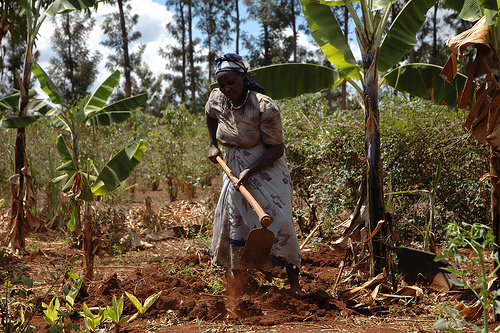
EL BATAN, Mexico (CIMMYT) — Farmer education programs that fail to address traditional gender roles may sideline women, limiting their use of conservation agriculture techniques, which can boost their ability to adapt to climate change, a new research paper states.
Conservation agriculture involves minimal soil disturbance, permanent soil cover and the use of crop rotation to simultaneously maintain and boost yields, increase profits and protect the environment. It contributes to improved soil function and quality, which can improve resilience to climate variability.
Although some scientists believe that such techniques have the potential to reduce greenhouse gas emissions and increase carbon sequestration, which can help mitigate the impact of global warming, it is important to note that the potential benefits of certain aspects of conservation agriculture — particularly not tilling the soil — have been overstated, write the authors of the study from the International Center for Maize and Wheat Improvement (CIMMYT) and the Research Program on Climate Change Agriculture and Food Security (CCAFS).
Titled “Gender and conservation agriculture in east and southern Africa: towards a research agenda,” the paper discusses the lack of research conducted into interactions between conservation agriculture use and gender. It proposes a research agenda that will better understand how African farming systems remain strongly stratified by gender.
Despite an increase of women smallholder farmers throughout sub-Saharan Africa – one of the most vulnerable regions to climate change worldwide – agricultural service suppliers and policymakers remain “locked into the conceptual norm of the primary farmer as male,” said co-author Clare Stirling, a senior scientist in the Sustainable Intensification Program at CIMMYT.
“The ability of women-led households, or male-headed households with women as primary farmers, to adopt conservation agriculture may be compromised if government policies, extension systems and other actors continue to design interventions and target information and training around the conceptual norm of the male-headed household,” Stirling said, adding that a gender-sensitive approach should become part of mainstream research.
“Overall, normative conceptualizations of ‘farmers’ can result in inappropriate targeting and ineffective messaging,” she said.
There is almost no understanding of how gender relations in smallholder agriculture – particularly with regard to decision-making over technology adoption, roles and responsibilities for specific farm tasks – may influence the likelihood of adopting conservation agriculture techniques, the paper states.
The costs and benefits of conservation agriculture adoption to women themselves — in terms of income, labor deployment, contributions to food and nutrition security and relative decision making power at household and community level, remain largely unknown.
In sub-Saharan Africa, about 30 percent of the population is undernourished, and the area has the highest projections for population growth by 2050, the paper states, adding that a projected 2 degree temperature increase related to global warming is likely to be accompanied by reduced rainfall and increased variability of weather patterns.
These factors will put pressure on agricultural systems that are largely small scale, low input, rain fed and already struggling to feed the population, according to the report. Cereal yields in the region are low and stagnant, averaging 1.3 tons per hectare, compared with 3 tons per hectare in the developing world overall.
Women and men typically take on distinctive, sex-segregated roles, responsibilities and tasks in agricultural production systems. While men and women may have different rights and responsibilities for different crops and livestock products, women are typically responsible for household tasks and caring roles.
“Women more than men are involved in a zero sum game, a closed system in which time or energy devoted to any new effort must be diverted from another activity,” the report states. Access to land, which in many sub-Saharan African countries is managed under customary law, or a patchwork of statutory and customary laws – is also complex and under-researched in terms of understanding the associations between gender, decisions about land management and the willingness of farmers to engage in conservation agriculture or indeed any new intervention that involves a delay in returns, according to the paper.
 Gender equality, youth and social inclusion
Gender equality, youth and social inclusion 